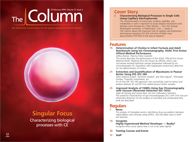Compositional Analysis of Honeybee Venom for Proteomics
Research into honeybee venom is being performed to identify active proteins acting as allergens and toxins. Researchers combined LC–MALDI-TOF/TOF-MS–MS, LC–ESI-QTOF-MS–MS, and a combinatorial peptide ligand library enrichment method to detect 269 proteins.
Photo Credit: Donald Jusa/Getty Images

Research into honeybee venom is being performed to identify active proteins acting as allergens and toxins.1 Researchers combined liquid chromatography–matrix-assisted laser desorption–ionization time-of-flight/time-of-flight tandem mass spectrometry (LC–MALDI-TOF/TOF-MS–MS), liquid chromatography–electrospray ionization quadrupole time-of-flight tandem mass spectrometry (LC–ESI-QTOF-MS–MS), and a combinatorial peptide ligand library enrichment method to detect 269 proteins.
Honeybee’s (Apis mellifera) possess complex venom containing numerous proteins and peptides with possible medical and biotechnological applications.2 Alternatively, venom components can act as allergens and toxins, which can be potentially deadly to humans. In order to develop antidotes against specific toxins, full venom characterization is required. Venom research may also provide potential targets for new drugs and lead to a better understanding between the structure of the molecules and their function.3 In theory this is a simple undertaking but the complexity of venom proteomes, that is, the entire set of proteins expressed by a genome, represents a major challenge for analytical chemists.
To address this challenge researchers from Poznan University of Medical Sciences in Poland, used complex enrichment strategies followed by LC–MS analysis. A lack of sensitivity in previous approaches using classical two-dimensional sodium dodecyl sulphate-polyacrylamide gel electrophoresis (2DSDS–PAGE) prevented exploration of low abundant venom components as well as low molecular weight fractions. Using hyphenated LC–MALDI-TOF/TOF-MS–MS and LC–ESI-QTOF-MS–MS techniques combined with combinatorial peptide ligand library enrichment, researchers hoped to better characterize honeybee venom composition.
In total this approach found 269 proteins whose biological function was determined using various proteomic platforms. Forty-nine toxins, allergens, and components involved in the envenoming mechanism including all 12 honeybee venom components approved as allergens by the International Union of Immunological Societies were identified. In addition, a number of previously uncharacterized proteins were found with five showing a close relation with known toxic or allergic proteins. The combination approach undertaken in this research resulted in a better visualization of the honeybee proteome and it is hoped will lead to a better understanding of the protein mechanisms involved in envenomation. The success of this method could have further implications in the studies of other notable venomous species. - L.B.
References
- J. Matysiak et al., J. Pharm. Biomed. Anal.121, 69–76 (2016).
- D.C. De Graff et al., J. Proteomics72, 145–154 (2009).
- J.J. Calvete et al., J. Mass Spectrom.42, 1405–1414 (2007).

New Study Reviews Chromatography Methods for Flavonoid Analysis
April 21st 2025Flavonoids are widely used metabolites that carry out various functions in different industries, such as food and cosmetics. Detecting, separating, and quantifying them in fruit species can be a complicated process.
Analytical Challenges in Measuring Migration from Food Contact Materials
November 2nd 2015Food contact materials contain low molecular weight additives and processing aids which can migrate into foods leading to trace levels of contamination. Food safety is ensured through regulations, comprising compositional controls and migration limits, which present a significant analytical challenge to the food industry to ensure compliance and demonstrate due diligence. Of the various analytical approaches, LC-MS/MS has proved to be an essential tool in monitoring migration of target compounds into foods, and more sophisticated approaches such as LC-high resolution MS (Orbitrap) are being increasingly used for untargeted analysis to monitor non-intentionally added substances. This podcast will provide an overview to this area, illustrated with various applications showing current approaches being employed.

.png&w=3840&q=75)

.png&w=3840&q=75)



.png&w=3840&q=75)



.png&w=3840&q=75)








